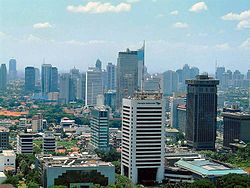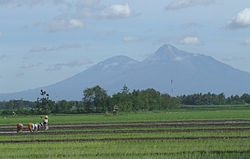Java (Indonesian: Jawa) is an island in Indonesia. The much smaller but still sizable island of Madura, off the coast of and covered as part of the region of East Java, is also included in this article.

Understand
Java is Indonesia's fifth-largest island, compromising only 7% of Indonesia's territory (127,569 sq. km), but 65% of Indonesia's entire population (130 million people) fills the island, it is the world's most populated island with a density of 940 people per sq. km!
Indonesia's most important cities are on this island. Jakarta, the capital of Indonesia, is located on Java's northwest coast. Surabaya (the second largest city in Indonesia), is located in East Java. Bandung (the third most populous city in Indonesia), is the capital city of West Java province. Yogyakarta and Surakarta (Solo), although not large in population are very significant centres of culture, in southern central Java.
The island of Java has distinct cultural zones. In the west Sundanese , Betawi in Jakarta. Javanese, for most of central and eastern javanese provinces with the Madurese at Madura Island. Smaller indigenous tribes include the Badui of the west and Tengger from the east.
This is a quite remarkable island with no less than 30 active volcanoes. Add to that a host of major national parks with lots to offer the visitor who appreciates outdoor attractions.
Regions

| West Java (Banten Province and West Java Province) (Anyer, Bandung, Banten, Bekasi, Bogor, Ciamis, Cianjur, Cirebon, Depok, Garut, Jakarta, Kampung Naga, Kepulauan Seribu National Park, Puncak, Mount Halimun Salak National Park, Pelabuhan Ratu, Sukabumi, Tasikmalaya, Tangerang, Ujung Kulon National Park) Includes the massive urban sprawl of Jakarta, to the south Bandung in the hills. |
| Central Java (Central Java Province and Yogyakarta Special Region) (Borobudur, Cilacap, Dieng Plateau, Jepara, Karimunjawa, Kendal (Java, Indonesia), Magelang, Mount Merapi, Parangtritis, Prambanan, Purwokerto, Salatiga, Semarang, Solo, Tegal, Yogyakarta) Charming Yogyakarta and significant ancient temples. |
| East Java (East Java Province which includes of Madura Island) (Baluran National Park, Banyuwangi, Batu, Blitar, Bojonegoro, Bromo-Tengger-Semeru National Park, Jember, Madiun, Madura, Malang, Pacitan, Probolinggo, Surabaya) Indonesia's second city Surabaya and stunning volcanic scenery. |
Cities

- Jakarta — the capital city and largest city of Indonesia. Virtually the island's economic & politic heartbeat and the whole country as a whole.
- Bandung — a cool city in a valley between the mountains. Gastronomic adventurers and budget travelers can head here.
- Surabaya — the largest city at East Java. A hidden charm with unique blend of Javanese, Madurese, and Chinese cultures.
- Yogyakarta — a city that is a historical and current centre of Javanese culture and tradition .
- Solo — a centre of Javanese culture and history, a long rival of Yogyakarta and different from it.
- Semarang — a city on the north coast, s regional capital and a busy coastal location.
- Bogor — another city in the mountains, magnificent gardens and cooler air.
- Malang — a cool and cultured place in the mountains in the eastern end of Java.
- Jember —
Other destinations
- Anyer - beautiful beach, gateway to Krakatoa volcano
- Baluran National Park - savannah grasslands which will make you think you are in Africa
- Bromo-Tengger-Semeru National Park - spectacular volcanic scenery, home of the Tenggerese
- Borobudur - the largest ancient Buddhist temple, a serious contender for the world's eighth wonder
- Madura - large, remote, arid island and off the beaten path for visitors
- Mount Halimun Salak National Park - the best and most complete rainforest area in Java, near Bogor
- Prambanan - ancient Hindu temple
- Sukamade - turtles come to lay their eggs virtually every night of the year
- Ujung Kulon National Park - anational park with unspoiled jungles, white sand beaches, corals and the last examples of the Javanese Rhinoceros, need permit to enter
Talk
While Indonesian (Bahasa Indonesia) is the lingua franca understood by almost everyone, the majority of Java's population also speak Javanese, a related but mutually incomprehensible language. As the largest single language in Indonesia, Javanese influence on Bahasa Indonesia has been quite significant, in Central and East Java local pronunciation changes — changes include a turning into o, so eg. Surabaya becomes Suroboyo.
Other significant local languages include Sundanese, spoken in West Java, Betawi in Jakarta and Madurese, spoken on and around the island of Madura.
At the border of the West Javan and Central Javan Provinces, the people use a combination of Sundanese language and Javanese language which confuses people who speak only Sundanese or Javanese.
Get in
By air
Most visitors arrive at Jakarta where most international airlines that fly to Indonesia land at, and has excellent connections to all points on Java. An increasing number of international carriers also fly to Bandung, Semarang, Solo, Yogyakarta, and Surabaya. Flying to these secondary airports can be dramatically cheaper than connecting from Jakarta thanks to the role of low cost carriers from Malaysia and Singapore, so you might want to transit at one of these two countries before heading here. Domestically, all the airports are well connected with more than 10 flights a day, most fly from Jakarta.
By sea
PT Angkutan Sungai Danau dan Penyeberangan/ASDP ferry services:
- Gianyar(Bali) from/to Gilimanuk (East Java)
- Bakauheni (Lampung/Southern Sumatra) from/to Merak (Banten). Rp 12,000 for a 2-3 hour journey
- Kamal (Madura) from/to Tanjung Perak (Surabaya). Due to operational of Suramadu (Surabaya Madura) Toll Bridge, avaibility and using of the ferries are less frequent
PT Pelayaran Nasional Indonesia/PELNI passenger ship routes include:
- Medan (North Sumatra) from/to Tanjung Priok (Jakarta)
- Pontianak (West Kalimantan) from/to Tanjung Priok (Jakarta)
- Makassar (South Sulawesi) from/to Tanjung Perak (Surabaya)
Get around
Java's infrastructure is comprehesive in - it is possible (but not advisable to try) to cross the entire island by land in a single (long) day. However, the sheer density of population means that roads, buses and trains can get overcrowded if you're moving at the same time as everyone else.
By bus
The main form of long-distance transport, vast armadas of buses cross the island and connect every city and mountain hamlet. Watch out though, as many drivers have near-suicidal driving habits that emphasize speed above all else. There are two type of buses, with aircon and without aircon; the fare of non-aircon is only about a third of using aircon. If you do take a bus, take one with aircon, because drivers of such buses are known to be safer, as a general rule. For long trips, people tend to use cheap airlines, because their fares are usually comparable to bus fare. However, in peak season, even 'cheap airlines' fares increase to 3 to 4 times the cost for air conditioned buses.
By train
Java has the most comprehensive railway network in Indonesia, with trains connecting the capital city of Jakarta with most other cities and towns in the island. The eksekutif class is the luxury class, and consequently the most expensive.
Ticket reservations can be made starting 90 days in advance. On-line ticket reservation is available through PT Kereta Api's ticketing site [1] and several other on-line ticket agent websites and also thousands of Alfamart and Indomart mini markets. Travelers can also buy ticket from a ticket agent's shop or local post office which is available in most of all cities in Indonesia. Either buying from internet or ticket shop, travelers will get printable voucher with Rp6,000 additional administration fee and it must be exchanged with the real ticket at the nearest or departure train station. Please remember that your name in the ticket should be same with your identity or you can't get into the train, if the name is different or you must pay double.
All transportation moda in Indonesia relatively are not facilitate need of disability persons. In October 2014, PT Kereta Api released a breakthrough with disability wagon(s) which has wide door, ample space for wheelchair and toilet for disability persons. No additional charge to use diability wagon. It is applied in new route through north of Java double tracks, Jakarta-Surabaya-Malang vice versa and gradually will be implemented to all executive long routes.
By road
Java's toll roads are built nearly to Western standards, with dual grade-separated lanes in both directions and elevated interchanges. Tolls are quite affordable, usually Rp 1,500-5,000 every 10 km or so. However, signage is often lacking and driving habits are atrocious, so it's very wise to pay a little extra and get a car with driver instead of attempting to drive yourself.
See

Java offers everything a somewhat adventurous traveler is looking for: two of world's great ancient monuments, volcanoes (all 121 of them), major national parks, rainforests, tea and rice plantations, large cities, big waves and even savanna. The scenery in most parts of Java is spectacular and, while the island is overpopulated, there are still plenty of unspoiled places. Even though the beaches are not very appealing in Java and tides can be fatal especially in south part of Java, except for surfing in Banyuwangi, East Java. In nearby archipelagos like Pulau Seribu or Karimunjawa the traveler can find white sand beaches and corals islands.
Do
- Trek in Ujung Kulon National Park and Mount Halimun Salak National Park, see good examples of rainforest and wild animal habitats.
- Dive in the pristine waters of the Karimunjawa islands.
- Rent a fisherman's boat and sail around the Kepulauan Seribu National Park archipelago.
- See the crater of a volcano real close at Tangkuban Perahu (in Bandung).
- Watch the sunrise at the breathtaking Bromo-Tengger-Semeru National Park.
- Surf one of the world's great waves at G-Land near Banyuwangi.
- Travel from Jakarta to Yogyakarta by day train. Beautiful landscapes and a cheap and more relaxing way to travel around Java.
- Visit the Dutch war cemeteries Menteng Pulo (central Jakarta) or Ancol (in the north of Jakarta by the sea). They are haunting and quiet getaways from the bustling city. To visit Ancol, take a taxi and ask for "makam kehormatan Ancol".
- Visit Kebun Raya (botanical gardens) in Bogor.

- Wake up early to see the sunrise at the Borobudur temple near Yogyakarta.
- Watch a spell-binding evening performance of The Ramayana against the lit backdrop of magnificent Prambanan.
- Climb the Gunung Gede volcano.
- Play golf at the Merapi Golf Course in Yogyakarta. The active volcano Mount Merapi looms over the course just a few miles away.
- Eat mie goreng from a street vendor ("kaki lima"). Try martabak. Eat ice-cream at Toko Oen in Malang.
- Visit the huge shopping malls at Jakarta.
- Enjoy a fine Sunday brunch in any Jakarta international hotel at an amazing value.
Drink
Boiled water or drink water from a sealed bottle. Tap water is not drinkable, except boiled or is filtered by small purifier. Coffee or tea, it's safe. The same applies to beer, which combines very well with hot Indonesian cuisine. Beers are relatively cheap, but other alcohol drinks with more than 5 percent alcohol are relatively expensive due to taxation.
Stay safe
Use common sense, as you would do in your own country. The most common crime for travellers to be aware of is theft. Violent crime is rare in Indonesia. However, it's wise to be extra cautious in Jakarta and other big cities, especially in crowds.
Traffic can be chaotic. Watch out for trucks, cars and other moving objects. One rule applies: "might is right". Don't expect traffic to respect pedestrian ("Zebra") crossings (even when a police(wo)man is in sight). When crossing a busy street - be confident, make sure your intentions are clear to the oncoming drivers. Cars never stop, but if they know what they can expect from you, they will avoid you. Using hand signal like put one hand in the air or signaling stop might help, too.
